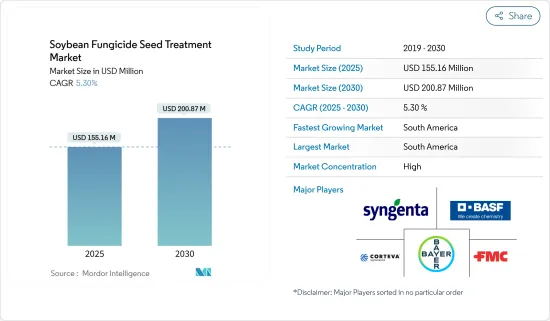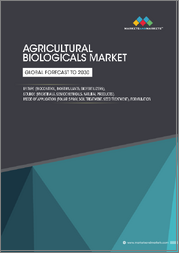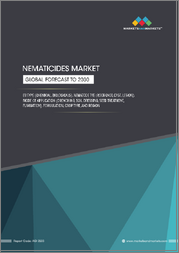
|
시장보고서
상품코드
1690928
대두 살균제 종자 처리 시장 : 시장 점유율 분석, 산업 동향, 성장 예측(2025-2030년)Soybean Fungicide Seed Treatment - Market Share Analysis, Industry Trends & Statistics, Growth Forecasts (2025 - 2030) |
||||||
대두 살균제 종자 처리 시장 규모는 2025년에 1억 5,516만 달러로 추정되고, 예측 기간인 2025-2030년 CAGR 5.30%로 성장할 전망이며, 2030년에는 2억 87만 달러에 달할 것으로 예측됩니다.

대두 살균제 종자 처리 시장은 농업 종사자가 건전한 수율을 유지하기 위해서 작물을 균류 병해로부터 지키는 것에 주력하고 있는 것으로부터 확대하고 있습니다. 대두는 피토프트라, 리조크토니아, 후자리움 등 토양과 종자를 매개하는 병원균에 의한 큰 위험에 직면해 있으며, 이들은 발아와 식물의 초기 개발에 영향을 미칩니다.
세계의 대두 소비량은 식품, 가축 사료, 산업 분야 전체에서 계속 증가하고 있습니다. 대두는 두부, 두유, 대용육 등 식물성 식품에 필수적인 단백질과 유지를 공급하고 있어 건강과 지속 가능성에 대한 우려로 인기가 높아지고 있습니다. 축산업에서는 가금류, 돼지, 소의 사료로 대두밀이 사용되고 있습니다. 세계의 가축소 마릿수는 이전의 15억 5,770만 마리에서 2023년에는 15억 7,570만 마리에 이르렀습니다. 바이오 연료 산업도 바이오 디젤 생산에 사용되는 대두유를 통해 수요를 증가시키고 있습니다. 인구의 증가와 식생활 기호의 변화가 이러한 소비의 성장을 유지하여 대두 살균제 종자 처리 시장을 더욱 견인하고 있습니다.
선진적인 살균제 제제는 복수의 병원균에 대한 보호를 강화합니다. 이러한 처리는 모종의 활력을 향상시켜, 균일한 생육을 확보해, 환경 스트레스에의 내성을 강화합니다. 산업은 기존의 약제 살포에서 표적을 좁힌 종자 처리로 이행하여 투입 비용과 살포의 복잡성을 줄이면서 작물의 생산성을 최대화하는 데 주력하고 있습니다.
대두 살균제 종자 처리 시장은 남미가 대부분을 차지하고, 그 중에서도 브라질과 아르헨티나는 대두 생산이 번성하기 때문에 큰 공헌을 하고 있습니다. 북미, 특히 미국은 진균 감염 위험을 높이는 다습 조건으로 인해 큰 시장 점유율을 차지하고 있습니다. 아시아태평양 시장은 특히 중국과 인도에서 대두 재배와 종자 처리 도입이 증가하면서 확대되고 있습니다. ITC의 무역 맵에 따르면 인도의 대두 수입량은 48만 9,500톤에서 72만 4,900톤으로 증가했습니다. 대두 살균제 종자 처리 시장은 대두 수요 증가를 배경으로 예측 기간 동안 확대가 예상됩니다.
대두 살균제 종자 처리 시장 동향
생물학적 종자 처리에 대한 수요 급증
선진 지역의 환경문제에 대한 관심이 생물학적 종자처리에 대한 수요를 높여 예측 기간 중 시장 성장을 견인하고 있습니다. 화학 기업은 생물학적 종자 처리의 제공을 확대하는 것으로 대응하고 있습니다. 미국에서는 대기업이 생물학적 처리와 화학적 처리를 결합한 대두 종자를 제공하고 있습니다. FAOSTAT에 따르면 캐나다의 대두 수확 면적은 2022년 211만 헥타르에서 2023년 226만 헥타르로 증가했습니다.
생물학적 종자 처리에는 살아있는 미생물, 발효 생성물, 식물 추출물, 식물 호르몬, 화학 화합물 등의 유효 성분이 포함되어, 식물의 개발에 도움이 됩니다. 이러한 처리는 식물의 성장을 가속하고, 스트레스를 경감하고, 식물의 유전적 잠재력을 극대화함으로써 수율을 증가시키는 능력에 의해 인기를 모으고 있습니다.
미국의 종자 처리 시장은 작물 소비 증가와 대두의 조기 이식 프랙티스에 의해 확대하고 있습니다. FAOSTAT에 따르면 대두 생산량은 2023년에 1억 1,330만 톤에 이르렀습니다. 습한 토양에서의 조기심기는 종자나 모종을 곤충, 질병, 해충에 노출시키는 경우가 많아 보호와 수확량 향상을 위해 종자 처리가 필요합니다. 미국 환경보호청(EPA)은 농작물이나 식품에 대한 화학농약 살포를 감독하고 있으며, 최근에는 많은 기업이 EPA 등록을 취득하고 있습니다.
생물학적 종자 처리 시장에 참가하는 기업도 늘고 있습니다. 2022년, 바스프스는 캐나다 대두 재배용으로 Veltyma Fungicide를 등록했습니다. 이 제품은 메펜트리플루코나졸(Revysol)과 피라클로스트로빈의 식물 건강상의 이점, 메토코나졸의 후잘륨 방제 능력을 조합하여 포괄적인 대두 병해 관리를 기재하고 있습니다.
시장을 독점하는 남미
남미는 세계 대두 생산과 수출의 대부분을 차지하고 있으며 브라질과 아르헨티나가 주요 공헌자입니다. FAO에 따르면 세계 최대 대두 생산국인 브라질은 세계 대두 생산량의 40% 이상을 차지하고, 아르헨티나는 수출 상위 국가의 지위를 유지하고 있습니다. 이 지역의 광대한 경지, 적절한 기후, 근대적인 농법은 식용, 사료용, 바이오 연료용 대두의 세계 수요를 충족시키는 대규모 생산을 가능하게 하고 있습니다. FAOSTAT에 따르면 대두 생산량은 2022년 1억 2,120만 톤에서 2023년 1억 5,210만 톤으로 증가했습니다. 브라질의 주요 대두 생산주인 마토그로수주, 파라나주, 리오 그란데 드 수르주는 국내 생산량의 대부분을 차지하고 있습니다. 아르헨티나의 팜파 지방은 확립된 농업 인프라에 힘입은 주요 대두 재배지입니다.
남미는 세계의 대두 수출 시장을 독점하고 있으며, 중국이 주요 수입국입니다. ITC 무역맵에 따르면 브라질의 대두 수출량은 2022년 7,890만 톤에서 2023년 1억 190만 톤으로 증가했으며, 아시아, 유럽, 북미 주요 시장에 공급됩니다. 아르헨티나는 브라질보다 생산량이 적음에도 불구하고 미르와 오일 등 대두 가공품 수출에 특화되어 있습니다. 브라질의 산토스항과 아르헨티나의 로사리오항 등 이 지역의 항만 인프라는 효율적인 세계 유통을 촉진하고 있습니다. 이러한 수출은 특히 대두 생산량이 제한된 지역에서 세계의 식량 안보와 축산업을 지탱하고 있습니다.
남미에서는 지속 가능한 농업의 요구와 환경 의식에 힘입어 바이오 종자 처리 살균제 수요가 증가하고 있습니다. 대두 농업 종사자들은 피토프트라 근부병, 후자리움 시들음병, 리조크토니아 고사병 등 작물의 수확량에 영향을 미치는 진균병과 싸우고 있습니다. 기존의 화학살균제에서 바이오 베이스 종자 처리로의 이행은 그 환경면에서의 이점과 종자의 발아나 작물의 초기 개발에 좋은 영향을 주는 것으로부터 계속되고 있습니다. 이러한 바이오 살균제는 천연 미생물과 식물 추출물을 이용하여 토양 조건을 개선하면서 진균 병원균을 방제하는 것으로 세계의 지속 가능성에 대한 대처를 지원하고 있습니다. 남미는 바이오 종자 처리 살균제와 같은 지속가능한 농업 프랙티스의 채용이 증가하고 있는 것에 가세해 강력한 생산 및 수출 능력에 의해서 시장에서의 지위를 유지하고 있습니다.
대두 살균제 종자 처리 산업 개요
세계의 대두 살균제 종자 처리 시장은 통합되어 있으며, Syngenta Group, BASF SE, Bayer Crop Science AG, Corteva Agriscience, FMC Corporation과 같은 주요 기업이 존재합니다.
기타 혜택
- 엑셀 형식 시장 예측(ME) 시트
- 3개월의 애널리스트 서포트
목차
제1장 서론
- 조사의 전제조건 및 시장 정의
- 조사 범위
제2장 조사 방법
제3장 주요 요약
제4장 시장 역학
- 시장 개요
- 시장 성장 촉진요인
- 대두 진균병의 발생률 증가
- 고품질 작물 수율에 대한 수요 증가
- 정부의 지원 및 대처
- 시장 성장 억제요인
- 화학 종자 처리 살균제의 악영향
- 농약에 대한 엄격한 규제
- Porter's Five Forces 분석
- 공급기업의 협상력
- 구매자의 협상력
- 신규 참가업체의 위협
- 대체품의 위협
- 경쟁도
제5장 시장 세분화
- 유형별
- 케미컬
- 논케미컬 및 바이오
- 지역별
- 북미
- 미국
- 캐나다
- 멕시코
- 기타 북미
- 유럽
- 독일
- 영국
- 프랑스
- 스페인
- 이탈리아
- 러시아
- 기타 유럽
- 아시아태평양
- 중국
- 일본
- 인도
- 태국
- 베트남
- 호주
- 기타 아시아태평양
- 남미
- 브라질
- 아르헨티나
- 기타 남미
- 아프리카
- 남아프리카
- 기타 아프리카
- 북미
제6장 경쟁 구도
- 가장 채용된 전략
- 시장 점유율 분석
- 기업 프로파일
- Syngenta Group
- Bayer CropScience AG
- BASF SE
- UPL
- Corteva Agriscience
- Sumitomo Chemical Co. Ltd
- FMC Corporation
제7장 시장 기회 및 향후 동향
AJY 25.05.09The Soybean Fungicide Seed Treatment Market size is estimated at USD 155.16 million in 2025, and is expected to reach USD 200.87 million by 2030, at a CAGR of 5.30% during the forecast period (2025-2030).

The soybean fungicide seed treatment market is growing as farmers focus on protecting crops against fungal diseases to maintain healthy yields. Soybeans face significant risks from soil- and seed-borne pathogens including Phytophthora, Rhizoctonia, and Fusarium, which affect germination and early plant development.
Global soybean consumption continues to rise across food, animal feed, and industrial sectors. Soybeans provide essential protein and oil for plant-based foods, including tofu, soy milk, and meat alternatives, which are increasing in popularity due to health and sustainability concerns. The livestock industry depends on soybean meal for feeding poultry, swine, and cattle. The global cattle population reached 1,575.7 million in 2023, up from 1,557.7 million previously. The biofuel industry also increases demand through soybean oil used in biodiesel production. Population growth and changing dietary preferences sustain this consumption growth further driving the soybean fungicide treatment market.
Advanced fungicide formulations provide enhanced protection against multiple pathogens. These treatments improve seedling vigor, ensure uniform growth, and strengthen environmental stress resistance. The industry is moving from traditional chemical applications to targeted seed treatments, focusing on maximizing crop productivity while reducing input costs and application complexity.
South America dominates the soybean fungicide seed treatment market, with Brazil and Argentina as major contributors due to extensive soybean production. North America, particularly the United States, represents a significant market share due to humid conditions that increase fungal infection risks. The Asia-Pacific market is expanding through increased soybean cultivation and seed treatment adoption, particularly in China and India. India's soybean imports increased to 724.9 thousand metric tons from 489.5 thousand metric tons, according to the ITC trade map. The market for soybean fungicide seed treatments is anticipated to expand during the forecast period, driven by increasing soybean demand.
Soybean Fungicide Seed Treatment Market Trends
Rapidating Demand for Biological Seed Treatment
Environmental concerns in developed regions are increasing the demand for biological seed treatments, driving market growth during the forecast period. Chemical companies are responding by expanding their biological seed treatment offerings. In the United States, major companies are providing soybean seeds treated with biological and chemical combinations. According to FAOSTAT, Canada's soybean harvested area increased from 2.11 million hectares in 2022 to 2.26 million hectares in 2023.
Biological seed treatments incorporate active ingredients such as living microbes, fermentation products, plant extracts, phytohormones, and chemical compounds to benefit plant development. These treatments are gaining popularity due to their ability to enhance plant growth, reduce stress, and increase yield by maximizing plant genetic potential.
The United States seed treatment market is expanding due to increased crop consumption and early soybean planting practices. FAOSTAT reports soybean production reached 113.3 million metric tons in 2023. Early planting in moist soils often exposes seeds and seedlings to insects, diseases, and pests, necessitating seed treatment for protection and yield improvement. The US Environmental Protection Agency (EPA) oversees chemical pesticide application on crops and food products, with numerous companies securing EPA registration in recent years.
Companies are increasingly entering the biological seed treatment market. In 2022, BASF SE registered Veltyma Fungicide for Canadian soybean farming. This product combines mefentrifluconazole (Revysol) with pyraclostrobin's plant health benefits and metconazole's Fusarium control capabilities to provide comprehensive soybean disease management.
South America Dominates the Market
South America dominates global soybean production and export, with Brazil and Argentina as major contributors. Brazil, the world's largest soybean producer, accounts for over 40% of global soybean output, while Argentina maintains its position among top exporters according to FAO. The region's extensive arable land, suitable climate, and modern farming practices enable large-scale production to meet global demand for soybeans in food, animal feed, and biofuels. According to FAOSTAT, soybean production increased from 121.2 million metric tons in 2022 to 152.1 million metric tons in 2023. Brazil's main soybean-producing states - Mato Grosso, Parana, and Rio Grande do Sul - constitute a significant portion of national output. Argentina's Pampas region serves as a primary soybean cultivation area, supported by established agricultural infrastructure.
South America controls the global soybean export market, with China as the primary importer. Brazil's soybean exports increased from 78.9 million metric tons in 2022 to 101.9 million metric tons in 2023, according to the ITC Trade map, supplying key markets in Asia, Europe, and North America. Argentina, despite lower production volumes than Brazil, specializes in exporting processed soybean products, including meal and oil. The region's port infrastructure, including Brazil's Santos Port and Argentina's Rosario Port, facilitates efficient global distribution. These exports support worldwide food security and livestock industries, particularly in regions with limited soybean production.
South America experiences increasing demand for bio seed treatment fungicides, driven by sustainable agriculture needs and environmental awareness. Soybean farmers combat fungal diseases including Phytophthora root rot, Fusarium wilt, and Rhizoctonia damping-off, which affect crop yields. The transition from conventional chemical fungicides to bio-based seed treatments continues due to their environmental benefits and positive effects on seed germination and early crop development. These biofungicides utilize natural microbes and plant extracts to control fungal pathogens while improving soil conditions, supporting global sustainability initiatives. South America maintains its market position through strong production and export capabilities, combined with increasing adoption of sustainable farming practices like bio seed treatment fungicides.
Soybean Fungicide Seed Treatment Industry Overview
The global market for soybean fungicide seed treatment is consolidated, with major players such as Syngenta Group, BASF SE, Bayer Crop Science AG, Corteva Agriscience, and FMC Corporation among others. Syngenta International AG occupies the largest market share, followed by BASF SE and Bayer Crop Science AG. Major players in the market have extended their product portfolio and taken the approach of expansion and partnerships to broaden their business and strengthen their position in the market.
Additional Benefits:
- The market estimate (ME) sheet in Excel format
- 3 months of analyst support
TABLE OF CONTENTS
1 INTRODUCTION
- 1.1 Study Assumptions and Market Definition
- 1.2 Scope of the Study
2 RESEARCH METHODOLOGY
3 EXECUTIVE SUMMARY
4 MARKET DYNAMICS
- 4.1 Market Overview
- 4.2 Market Drivers
- 4.2.1 Increasing Incidence of Soybean Fungal Diseases
- 4.2.2 Growing Demand for High-Quality Crop Yield
- 4.2.3 Government Support and Initiatives
- 4.3 Market Restraints
- 4.3.1 Adverse Effect of Chemical Seed Treatment Fungicides
- 4.3.2 Stringent Regulations on Agrochemicals
- 4.4 Porter's Five Force Analysis
- 4.4.1 Bargaining Power of Suppliers
- 4.4.2 Bargaining Power of Buyers
- 4.4.3 Threat of New Entrants
- 4.4.4 Threat of Substitutes
- 4.4.5 Degree of Competition
5 MARKET SEGMENTATION
- 5.1 Type
- 5.1.1 Chemical
- 5.1.2 Non-Chemical/Biological
- 5.2 Geography
- 5.2.1 North America
- 5.2.1.1 United States
- 5.2.1.2 Canada
- 5.2.1.3 Mexico
- 5.2.1.4 Rest of North America
- 5.2.2 Europe
- 5.2.2.1 Germany
- 5.2.2.2 United Kingdom
- 5.2.2.3 France
- 5.2.2.4 Spain
- 5.2.2.5 Italy
- 5.2.2.6 Russia
- 5.2.2.7 Rest of Europe
- 5.2.3 Asia Pacific
- 5.2.3.1 China
- 5.2.3.2 Japan
- 5.2.3.3 India
- 5.2.3.4 Thailand
- 5.2.3.5 Vietnam
- 5.2.3.6 Australia
- 5.2.3.7 Rest of Asia-Pacific
- 5.2.4 South America
- 5.2.4.1 Brazil
- 5.2.4.2 Argentina
- 5.2.4.3 Rest of South America
- 5.2.5 Africa
- 5.2.5.1 South Africa
- 5.2.5.2 Rest of Africa
- 5.2.1 North America
6 COMPETITIVE LANDSCAPE
- 6.1 Most Adopted Strategies
- 6.2 Market Share Analysis
- 6.3 Company Profiles
- 6.3.1 Syngenta Group
- 6.3.2 Bayer CropScience AG
- 6.3.3 BASF SE
- 6.3.4 UPL
- 6.3.5 Corteva Agriscience
- 6.3.6 Sumitomo Chemical Co. Ltd
- 6.3.7 FMC Corporation



















